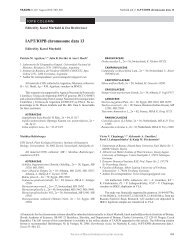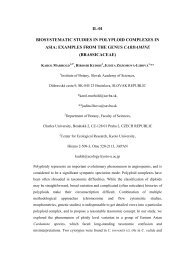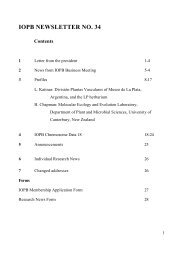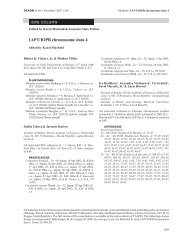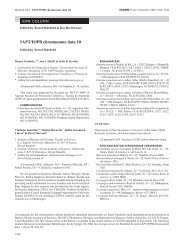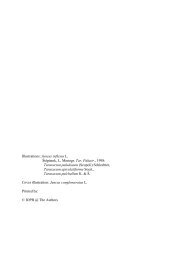CONTENS - International Organization of Plant Biosystematists
CONTENS - International Organization of Plant Biosystematists
CONTENS - International Organization of Plant Biosystematists
You also want an ePaper? Increase the reach of your titles
YUMPU automatically turns print PDFs into web optimized ePapers that Google loves.
O 09<br />
Phylogeny and biogeography <strong>of</strong> selected plant groups from the<br />
Balkan Peninsula<br />
Božo Frajman 1 & Peter Schönswetter 2<br />
1 Biology Department, Biotechnical Faculty, University <strong>of</strong> Ljubljana, Večna pot 111, SI-<br />
1000 Ljubljana, Slovenia. E-mail: bozo.frajman@bf.uni-lj.si<br />
2 Department <strong>of</strong> Biogeography and Botanical Garden, University <strong>of</strong> Vienna, Rennweg<br />
14, A-1030 Vienna, Austria. E-mail: peter.schoenswetter@univie.ac.at<br />
The Balkan Peninsula is renowned for its biodiversity and high levels <strong>of</strong> endemism<br />
both among animals and plants. Still, biota <strong>of</strong> some parts <strong>of</strong> the Balkans ranges<br />
among the least known in Europe. Studies using modern molecular approaches are<br />
largely lacking, with the exception <strong>of</strong> some recent phylogenetic and phylogeographic<br />
studies.<br />
One <strong>of</strong> the genera with several endemics described from the Balkans is Heliosperma<br />
(Sileneae, Caryophyllaceae). Phylogenetic and phylogeographic studies using<br />
chloroplast and nuclear DNA sequences as well as AFLP data suggest complex<br />
reticulate patterns and molecular data do not support traditional taxonomic<br />
delimitations within the H. pusillum group. Chloroplast data suggest an old split within<br />
the group, which is geographically correlated. This is not supported by nuclear data,<br />
possibly due to hybridisation between the two groups. Molecular dating suggests a<br />
recent, most probably Pliocene/Pleistocene diversification within the group. On the<br />
contrary, H. macranthum from Montenegro/Albania/Kosovo, is likely <strong>of</strong> more ancient<br />
Tertiary origin. The general assumption that many Balkan endemics are Tertiary<br />
relics has thus to be taken with caution.<br />
Another plant group including several Balkan endemics is the Euphorbia barrelieri<br />
group. Phylogenetic studies using nuclear and chloroplast DNA sequences reveal<br />
patterns different from traditional classifications. ITS data suggest that Euphorbia<br />
barrelieri from Italy is not most closely related to E. barrelieri from the Balkan<br />
Peninsula. Euphorbia nicaeensis and E. glareosa are nested within this group and E.<br />
herzegovina is most closely related to E. nicaeensis. Euphorbia kerneri and E. triflora<br />
are most closely related, whereas E. saxatilis from the Eastern Alps forms an<br />
independent lineage. Additional sampling is needed to corroborate these preliminary<br />
results.<br />
10



